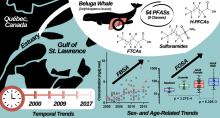| Title | Characterizing the metal(loid) contribution to the oxidative potential of thoracic-sized road dust particles. |
| Publication Type | Journal Article |
| Year of Publication | 2025 |
| Authors | Das, S, Peng, H, Wiseman, CLS |
| Journal | Environ Pollut |
| Volume | 383 |
| Pagination | 126785 |
| Date Published | 2025 Jul 06 |
| ISSN | 1873-6424 |
| Abstract | To better link airborne PM exposures with toxic endpoints, measurements of oxidative potential (OP) could be an important metric to supplement existing mass-based approaches. The OP of airborne PM has been previously examined elsewhere using acellular chemical assays. The OP of road dust, which is an airborne source of metal(loid)s capable of inducing the generation of reactive oxygen species (ROS), has yet to be characterized. To address existing knowledge gaps, the OP of < 10 μm road dust fractions (n = 27) previously collected in Toronto, Canada, using regenerative-air street sweepers, was measured using the ascorbic acid (AA) and the dithiothreitol (DTT) assays. The lung simulant Gamble's solution was used to characterize the OP of total, soluble and insoluble fractions. Stock solutions of V, Cr, Mn, Fe, Ni, Co, Cu, Sb, and Pb were also examined to assess the relative importance of metal(loid)s to OP. To generate an approximate volumetric estimate of the road dust contribution to ambient OP, the mass-based measurements from both chemical assays were modeled using AERMOD. Soluble elemental fractions accounted for 84 ± 39% and 65 ± 26% of total OP measured using the AA and DTT assays, respectively. Most notably, soluble Cu, Fe, and Mn were found to be primary drivers of OP, estimated to account for 83 ± 39% of total OP in the AA assay. These elements amounted to 59 ± 26% of total OP using DTT, which is less sensitive to the presence of inorganic constituents. AERMOD modeling revealed that arterial road dust contributed a mean OP of 1.20 ± 0.41 nmol/min/m and OP of 1.16 ± 0.23 nmol/min/m within 20 m of the road. The results highlight the importance of road dust in contributing to the potential of airborne PM to induce oxidative stress in the lung. |
| DOI | 10.1016/j.envpol.2025.126785 |
| Alternate Journal | Environ Pollut |
| PubMed ID | 40628354 |
Environmental Chemical Biology

